固定收益证券Chapter6-1
- 格式:pdf
- 大小:634.04 KB
- 文档页数:33

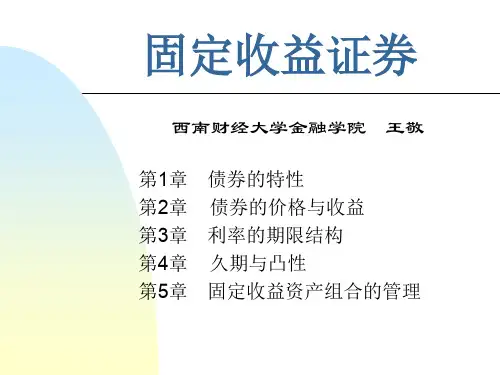

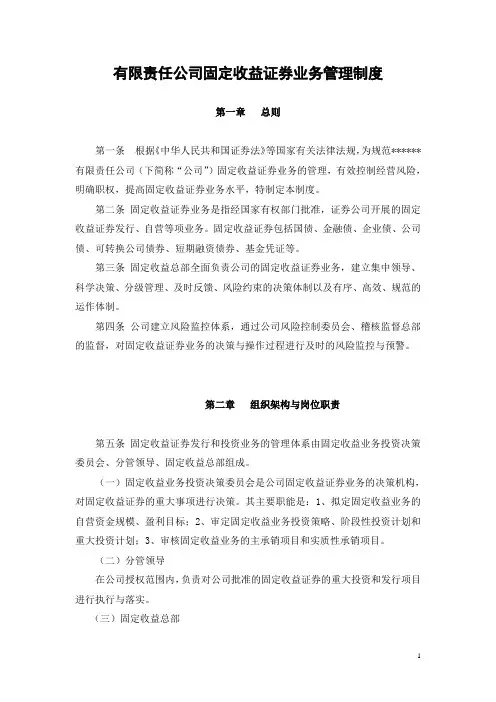
有限责任公司固定收益证券业务管理制度第一章总则第一条根据《中华人民共和国证券法》等国家有关法律法规,为规范******有限责任公司(下简称“公司”)固定收益证券业务的管理,有效控制经营风险,明确职权,提高固定收益证券业务水平,特制定本制度。
第二条固定收益证券业务是指经国家有权部门批准,证券公司开展的固定收益证券发行、自营等项业务。
固定收益证券包括国债、金融债、企业债、公司债、可转换公司债券、短期融资债券、基金凭证等。
第三条固定收益总部全面负责公司的固定收益证券业务,建立集中领导、科学决策、分级管理、及时反馈、风险约束的决策体制以及有序、高效、规范的运作体制。
第四条公司建立风险监控体系,通过公司风险控制委员会、稽核监督总部的监督,对固定收益证券业务的决策与操作过程进行及时的风险监控与预警。
第二章组织架构与岗位职责第五条固定收益证券发行和投资业务的管理体系由固定收益业务投资决策委员会、分管领导、固定收益总部组成。
(一)固定收益业务投资决策委员会是公司固定收益证券业务的决策机构,对固定收益证券的重大事项进行决策。
其主要职能是:1、拟定固定收益业务的自营资金规模、盈利目标;2、审定固定收益业务投资策略、阶段性投资计划和重大投资计划;3、审核固定收益业务的主承销项目和实质性承销项目。
(二)分管领导在公司授权范围内,负责对公司批准的固定收益证券的重大投资和发行项目进行执行与落实。
(三)固定收益总部在分管领导的直接领导下,负责具体实施公司的固定收益证券投资及发行业务,完成公司下达的固定收益证券投资经营任务。
第六条固定收益总部内部业务管理体系固定收益总部内部业务管理组织框架图(一)固定收益总部业务决策小组总经理、副总经理、投资部、发行销售部和同业合作部的部门经理组成固定收益总部业务决策小组。
固定收益证券承销与投资项目的总体规模、策略、计划、赢利目标以及项目实施过程中出现的问题和对策,由固定收益总部业务决策小组提出并按授权决策或报批。
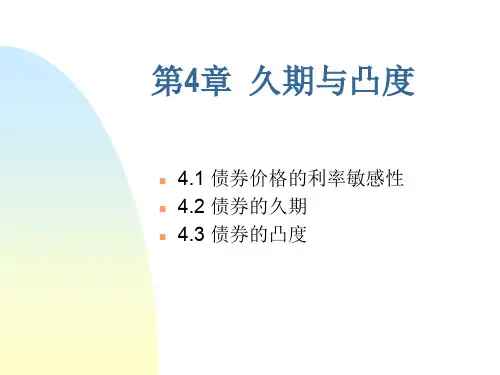

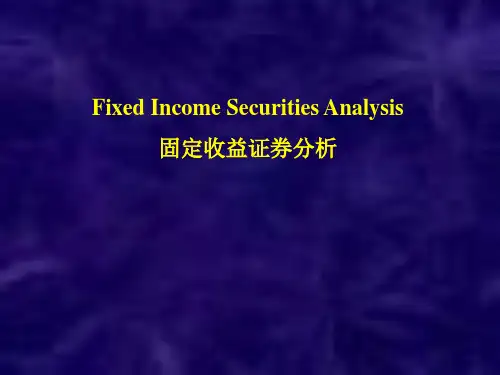


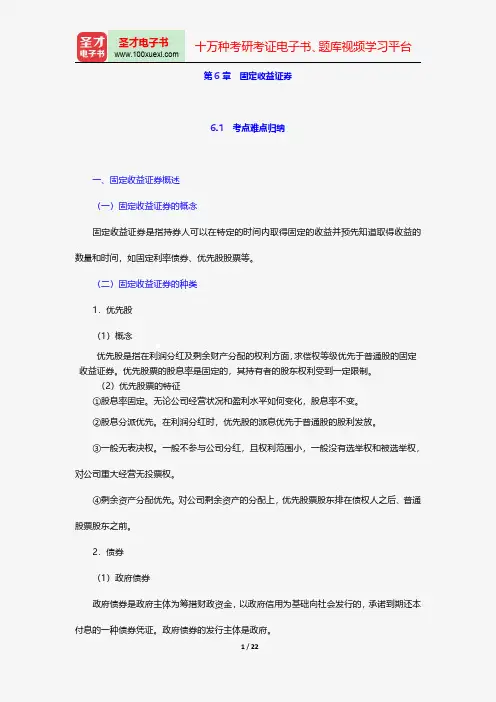
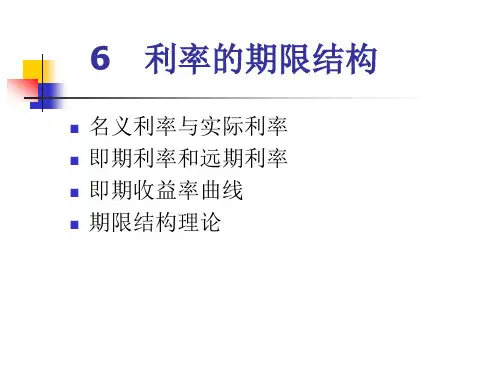
CFA固定收益证券Chapter 6.1 Credit Risks and Credit RatingAgencies第六章第一节:信用风险与信用评级机构Credit risk is the risk of loss resulting from the borrower (issuer of debt) failing to make full and timely payments of interest and/or principal.Credit risk has two components:•The first is known as default risk, or default probability, which is the probability that a borrower defaults—that is, fails to meet its obligation to make full and timely payments of principal and interest, according to the terms of the debt security.•The second component is loss severity (also known as “loss given default”) in the event of default—that is, the portion of a bond’s value (including unpaid interest) an investor loses.Expected loss = Default probability ×Loss severity given default ( or loss severity)Recovery rate is the percentage of a bond’s value an investor will receive if the issuer defaults.Loss severity (%) = 1 –recovery rateCorporate bonds and other “credit-risky” debt instruments typically trade at a yield premium, or spread, to bonds that have been considered“default-risk free,” such as US Treasury bonds.Bonds with credit risk trade at higher yields than bonds thought to be free of credit risk. The difference in yield between a credit-risky bond and a credit-risk-free bond of similar maturity is called yield spread.For example: a 5-yr corporate bond is trading a spread of +250bps to Treasury Bonds and yield on 5-yr Treasury bond is 4%Yield on corporate bond = 4% + 2.5% = 6.5%Bond prices are inversely related to spreads; a wider spread implies a lower bond price and a narrower spread implies a higher price. The size of the spread reflects the creditworthiness of the issuer and the liquidity of the market for the bond.Spread risk is the possibility that a bond’s spread will widen due to the following factors:•Credit migration risk or downgrade risk. This is the risk that a bond issuer’s creditworthiness deteriorates, or migrates lower, leading investors to believe the risk of default is higher and thus causing the yield spreads on the issuer’s bonds to widen and the price of its bonds to fall.•Market liquidity risk. This is the risk that the price at which investors can actually transact—buying or selling—may differ from the price indicated in the market.Brokers/dealers’ ability and willingness to make markets, as reflected in the bid–ask spread, is an important determinant of market liquidity risk.Each category of debt from the same issuer is ranked according to a priority of claims in the event of default. A bond’s priority of claims to the issuer’s assets and cash flow is referred to as its seniority ranking. Broadly, there is secured debt and unsecured debt. Unsecured bonds are often referred to as debentures. Secured debt means the debt-holder has a direct claim—a pledge from the issuer—on certain assets and theirassociated cash flows. Unsecured bondholders have only a general claim on an issuer’s assets and cash flow.Secured debt can be distinguished as first lien or first mortgage, senior secured, or junior secured debt. Unsecured debt is divided into senior, junior, subordinated gradation.First Lien or First Mortgage Senior SecuredJunior SecuredSenior UnsecuredSenior SubordinatedSubordinatedJunior SubordinatedRecovery rate are highest for debt with highest priority of claims. The lower the seniority ranking of a bond, the higher its credit risk. Investors require a higher yield to accept a lower seniority ranking.In the event of bankrupt or reorganization, a strict priority of claims, however, it is not always applied in practice. In some cases lower priority debt-holders may get paid even if senior debt-holder are not paid in full. During bankruptcy proceeding, the value of a company’s assets could deteriorate due to loss of customers and employees. To avoid unnecessary delay, negotiation and compromise among various claimholders mayresult in the reorganization plan that does not strictly conform to theoriginal priority of claims. By such a vote or by order of the court, the final plan may differ from absolute priority.Credit rating agencies assign ratings to categories of bonds with similar credit risk. Rating agencies rate both the issuer and the debt issues, or bonds themselves.Issuer credit ratings are called corporate family ratings (CFR), while issue-specific ratings are called corporate credit ratings (CCR).Issuer ratings are based on the overall creditworthiness of the company.The issuers are rated on their senior unsecured debt.Bonds rated triple-A (Aaa or AAA) are said to be “of the highest quality, with minimal credit risk” and thus have extremely low probabilities of default.Bonds rated Baa3/BBB–or higher are called “investment grade.”Bonds rated Ba1 or lower by Moody’s and BB+ or lower by S&P and Fitch, respectively, have speculative credit characteristics andincreasingly higher default risk. As a group, these bonds are referred to ina variety of ways: “low grade,” “speculative grade,” “non-investmentgrade,” “high yield,” and, in an attempt to reflect the extreme level of risk, some observers refer to these bonds as “junk bonds.”Credit Rating and “Notching”Cross-default provisions means events of default such as non-payment of interest on one bond trigger default on all outstanding debt.Specific issues may be assigned different credit ratings—higher or lower—due to a ratings adjustment methodology for the same issuer, known as notching.An example of a factor considered by rating agencies is structural subordination, which can arise when a corporation with a holdingcompany structure has debt at both its parent holding company andoperating subsidiaries.A subsidiary’s debt covenants may restrict the transfer of cash or assets“upstream” to the parent before subsidiary’s debt is serviced. Eventhough the parent’s bonds are not junior to the subsidiary’s bonds, the subsidiary’s bonds have priority claim to the subsidiary’s cash flow or assets.Risks Relying on Rating from Credit Rating AgenciesCredit ratings can change over time. Over a long time period (e.g., many years), credit ratings can migrate—move up or down—significantly from what they were at the time of bond issuance. Note that the higher the credit rating, the greater the ratings stability.Rating agencies may make mistakes. Rating agencies are not perfect, rating mistakes occur from time to time.Event risk is difficult to assess. Leveraged transactions, such as debt-financed acquisitions and large stock buybacks (share repurchases), are often difficult to anticipate and thus to capture in credit ratings.Credit ratings tend to lag the market pricing. Bond prices and credit spreads frequently move more quickly because of changes in perceived creditworthiness than rating agencies change their ratings (or evenoutlooks) up or down.。